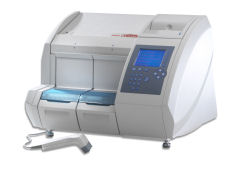- Home
- New Clients
- About Us
- Veterinary Services
- Pet Wellness and Vaccination Programs
- Pet Medical Services
- Pet Surgery Services
- Pet Reproductive Services in Fort Worth
- Pet Health Screening Tests
- Avian and Exotic Medicine and Surgery
- Additional Services
- Pet Acupuncture Therapy
- Pet Rigid and Flexible Endoscopy
- Laparoscopic Spays
- CT Scanning & Fluoroscopy
- Pet Physical Therapy and Rehabilitation
- Veterinary Second Opinions
- Dog, Cat, Bird and Exotics Boarding & Daycare
- Pet Grooming Salon and Dog and Cat Day Spa
- Veterinary Virtual Client Consultation
- TPLO (Tibial Plateau Leveling Osteotomy)
- Forms
- Information
- Online Store
- More
- Contact Us
|
|
|
 |
Summerfields Animal Hospital
(817)485-8511
www.summerfieldsanimalhospital.com
Ovulation Timing & In-Hospital Lab Services
Progesterone is a hormone measurable in the blood of the in heat female dog. Progesterone rises after the luteinizing hormone peaks and continues to rise whether the female dog is bred or not, pregnant or not for the next 60 days or so. Progesterone is a excellent tool for breeders to determine breeding dates. Bitches are best bred when the progesterone is 9.5 through 10ng/ml. Our in house laboratory uses an in house Progesterone and Leuteinizing Hormonal Assays of analytical laboratory quality. Made by bioMérieux Industry, our testing analyser requires special training in it’s use. In our laboratory, every effort is made to assure reliable, precise and rapid same day results (within 3 to 12 hours). The recommendations we make to breeders are based on the experience with the testing method we use. So, if you have heard how wonderful progesterone and luteinizing hormonal testing is for timing the breeding, that is right!!! Progesterone and LH testing is much better than doing a vaginal smear. But, be aware that the sampling techniques and progesterone and LH testing and kits differ dramatically. Always ask your veterinarian as to their testing methods.
Below is an article written to help provide an overview of the current technology and techniques available at Summerfields Animal Hospital. Ovulation TimingWritten By: Kit Kampschmidt, D.V.M. The investment of time and money you make in planning and implementing a breeding is significant. Pregnancy and the delivery of a healthy litter are the goal. When factors beyond your control prevent successful mating your investment is at risk. Proper ovulation timing increases the chance of success for any breeding. Artificial insemination can make the seemingly impossible breeding a reality. Your increased understanding will enable us to help make your breeding program more successful. Ovulation Timing Ovulation timing (or the timing of the fertile period) should be undertaken in any costly or important breeding. In situations where variables are introduced which are not present in a natural breeding situation it is very important. Due to the fact that behavioral estrous and hormonal estrous do not always coincide in their onset or duration, it is important to determine the fertile period as precisely as possible. Behavioral estrous is the period of receptivity (or standing heat) the bitch displays to the stud dog. The fertile period is the actual period during which ova may be fertilized. The bitch’s estrous cycle is a complex event and is dependent on the interaction of multiple hormones. Progesterone and Luteinizing Hormone (LH) figure prominently in the determination of ovulation. Normally, LH is present in the bitch’s blood in very small quantities. Just prior to ovulation there is a significant increase in serum LH values. LH can return to baseline levels within a 24-hour period. It is this surge of LH that triggers ovulation and thus determines the fertile period of the bitch. Hormonal estrous is defined as the period between the LH peak and diestrous. All events subsequent to the LH surge are consistent between bitches, regardless of breed or age. Therefore, LH is the central event of the estrous cycle, and determination of the preovulatory LH surge is the most accurate diagnostic tool for timing breedings. The LH surge can occur anywhere between 3 and 28 days after the first observable signs of heat, although the average is 8-12 days. Ovulation occurs 2 days after the LH surge. The eggs then take an additional 2 to 3 days to complete maturation. At that point they can support fertilization and live an additional 48-72 hours. Thus the fertile period of the bitch falls between days 4 and 7 after the LH surge. The most consistently fertile days are days 5 and 6 after the LH surge. (The first day of the LH surge is counted as day 0.) Progesterone, another important reproductive hormone in the bitch, is present in low levels before the LH surge and then begins to rise around the time of the LH surge. LH causes the luteinization of the ovarian follicles after the eggs are released. These areas on the ovaries are where progesterone is produced in levels high enough to maintain pregnancy in the bitch. Ovulation timing can also be performed by detecting this rise in progesterone, although it is not as precise as measuring LH. For most natural matings or artificial inseminations with fresh semen, breeding should begin 2-3 days after the LH surge, and continue every 2 or 3 days until the end of the calculated fertile period. When using chilled (extended) or frozen semen, or a stud dog with compromised semen quality, breedings should occur on the most fertile days (days 4,5 and 6 post LH surge). Gestation length is also determined by the date of the LH surge. In the bitch, gestation is 65 days (plus or minus 1 day) from the LH surge. This will be true regardless of what days the bitch is bred. Therefore, the most accurate way to predict whelping date is to know the date of the LH surge. This may be determined by direct LH testing or calculated from the rise in progesterone detected by a series of progesterone tests. Whelping date may also be estimated by gauging the first day of diestrous, either behaviorally or more accurately by vaginal cytology. This information can be invaluable when planning an elective C-section, or when deciding if intervention in the pregnancy and whelping process is necessary. LH can be measured by an in-clinic test that veterinarians can easily perform utilizing a small sample of blood. Testing must be performed daily since the duration of the LH surge can be as short as 24 hours. Once the LH surge is identified ovulation should be confirmed with a progesterone assay done 2-3 days later. Progesterone testing can be done with a number of in-clinic assays available. These in-clinic tests are semi-quantitative (estimations of actual levels of hormone). Quantitative assays can also be performed at outside medical laboratories. Quantitative assays provide the most accurate results. These tests are much more reliable and repeatable than in-clinic progesterone assays. Vaginal cytology and Vaginoscopy are additional procedures that most veterinarians will utilize along with the bitches behavior to fine tune the timing process. Neither technique is accurate enough by itself to determine the fertile period. Whatever methods you choose to complete your ovulation timing and insemination process, you and your veterinarian should discuss beforehand the risks, costs and chances of success associated with breeding. |





